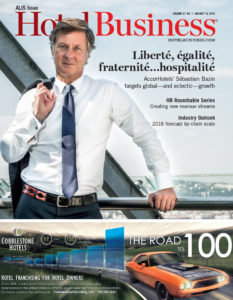 As global brand leader of JW Marriott Hotels & Resorts and The Luxury Collection, Mitzi Gaskins knows what the luxury traveler wants. Here, the Texas native discusses what guests expect from luxury hotels and what’s next for the two brands she oversees.
As global brand leader of JW Marriott Hotels & Resorts and The Luxury Collection, Mitzi Gaskins knows what the luxury traveler wants. Here, the Texas native discusses what guests expect from luxury hotels and what’s next for the two brands she oversees.
How would you define the modern-day luxury traveler? Today’s luxury traveler is focused on experiential travel, looking to learn new things while traveling. They crave inspiration, the thrill of exploration and connectivity to culture. We’ve found that the JW Marriott guest continues to seek out more thoughtful offerings that enrich their lives, as well as provide a personalized touch to the luxury travel experience.
One of the things most guests want today—across all segments—is curated, personalized experiences that immerse guests in the locale. How do you incorporate this into your hotels, especially in terms of potential local partnerships? Each JW Marriott property is authentic to its location, while embodying the warmth and essence of the JW brand. We pride ourselves on providing luxury without pretense and a strong focus on intuitive service and thoughtful programming. We’ve always strived to find new ways to offer elevated and enriching experiences to guests through original amenities and partnerships. For example, over the past few years, JW Marriott has been working to perfect our brand signatures in our public spaces in properties such as JW Marriott Chicago, JW Marriott Singapore South Beach and JW Marriott Mall of America in Minnesota, among others, in hopes to reinvent how travelers experience communal spaces. The program is built upon our guest passion points, and JW has tapped local partners to create experiences that align with our guests’ interests. In the lobby at JW Marriott Singapore South Beach, there is the Concierge Library—a social space hosted by the hotel concierge—and the Activity Table, which offers partner-hosted wine and cheese tastings, coffee experiences, chef-led culinary events and more.
What are the most important criteria when evaluating a potential local partner? Our approach to choosing a local partner is truly unique from one property to the next, and depends on the demographic and location of the hotel. As our guests are incredibly passionate about culinary, culture and well-being, we typically partner with leaders and tastemakers in each of those arenas to inform various elements of the guest experience.
Sometimes our locally based partnerships grow into brand-wide initiatives. For example, The Joffrey Ballet is a leading cultural institution that we originally partnered with at our JW Marriott Chicago hotel where they are based. That partnership naturally grew to the brand level where we saw an opportunity to work to create additional programming that are both consumer- and associate-facing. We created the Poise & Grace program, which is a training for our associates based on the principles of ballet, such as how to be fully present and properly engage with our guests. That program was a great success, so we further expanded this partnership and introduced Behind the Barre, a new in-room, on-demand workout program created in partnership with Joffrey Ballet.
Wellness and F&B are two areas of the hotel that have seen quite a bit of interest in recent years. In your opinion, what do luxury brands need to be doing to excel in these areas? It’s quite simple: Brands need to listen to their guests. We spend a lot of time paying close attention to guest feedback, and we tailor our culinary, health and wellness offerings to their needs.
For example, many of our guests—both business and consumer travelers—do not have the luxury of time, though are still seeking a moment of relaxation and recharge while on-property. In response, we developed Spa by JW, an international brand-wide concept, featuring express spa suites with treatments that start at a 12-minute entry point and are bookable without an appointment.
Our guests were also requesting additional immersive experiences that take a deeper approach to both wellness and culinary. We recently announced a new partnership with health & wellness leader Nora Tobin, naming her as the brand’s wellness ambassador, and will be rolling out an array of guest experiences throughout 2018 that include on-property, guided fitness videos, immersive retreats and customized culinary programming. We are also debuting Venice Food & Wine Festival, which will be held in May at JW Marriott Venice in partnership with Food & Wine. The exclusive three-day experience will showcase the best of Italian cuisine, wine and spirits to JW Marriott guests.
You oversee two of Marriott’s eight luxury brands. Since the Starwood acquisition, how have the additional brands impacted differentiation? By having eight of the world’s most powerful luxury brands, we now have a front seat to what is happening with luxury travel. We believe that having insight and strategic guidance of the positioning of each of these brands gives us an advantage over when they were competitors. By having them together, we are keeping them further apart. We have made some small tweaks to the positioning of JW Marriott and The Luxury Collection to ensure we can clearly articulate the positioning from some of our other brands that have target customers that share the same DNA.
How do you see luxury evolving? Guests will be seeking even more personalization and access—whether that is in on- or off-property experiences. We are also finding that more and more travelers are seeking community, culture and creation while traveling—they don’t want the typical luxury stay of yesteryear. Social media will also continue to dictate demand. It has played an extremely important role in exposing luxury hotels and resorts to potential travelers across the globe. Guests are now making decisions on where to travel based on their Instagram feeds, and can share their own personal adventures with both friends and strangers alike while staying at our properties.
The Luxury Collection is set to debut 10 properties next year. Tell me a bit about the pipeline. With a rapidly expanding global portfolio, The Luxury Collection embodies experiential travel and provides global explorers true, indigenous experiences, impossible to replicate anywhere else. A robust 2018 pipeline will bring Luxury Collection properties to captivating destinations including Los Cabos (Mexico), Savannah (GA), Vail (CO) and Okinawa (Japan).
And JW Marriott? Our growth strategy is dynamic, yet strategic and thoughtful. In just a few years, JW Marriott has grown to become a global brand with more than 80 hotels in over 30 countries worldwide. Debuting in destinations such as Venice, Los Cabos, Phu Quoc and in my home state in Austin are milestones I’m very proud to be a part of. We were recently ranked as the number-one luxury brand on JD Power’s Guest Satisfaction Survey, which is a huge indication we are on the right path. We are scheduled to open 50 new hotels by 2021.
JW Marriott has plans for renovations in more than half of its existing properties. How will these renovations reflect the modern luxury traveler and the communities in which the hotels are located? We will be revitalizing some of our iconic properties globally in 2018, including hotels and resorts in North America, the United Kingdom, China and South America, totaling more than $300 million in investment. Specific properties include a full-scale renovation of Grosvenor House, A JW Marriott Hotel, in London; a guestroom refresh of JW Marriott Cancun in Mexico; a fresh, new design of all JW Marriott Essex House New York’s guestrooms and suites; and a full redesign of JW Marriott Hong Kong’s interiors. Each property celebrates the heritage and locality of its destination—from Mayan-inspired design at JW Marriott Cancun to a polished glamour at JW Marriott Essex House. HB

